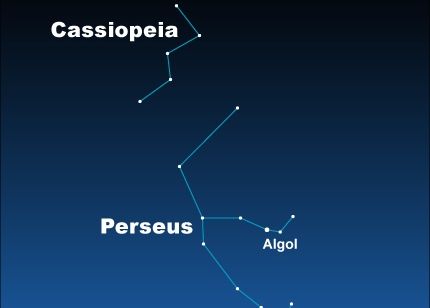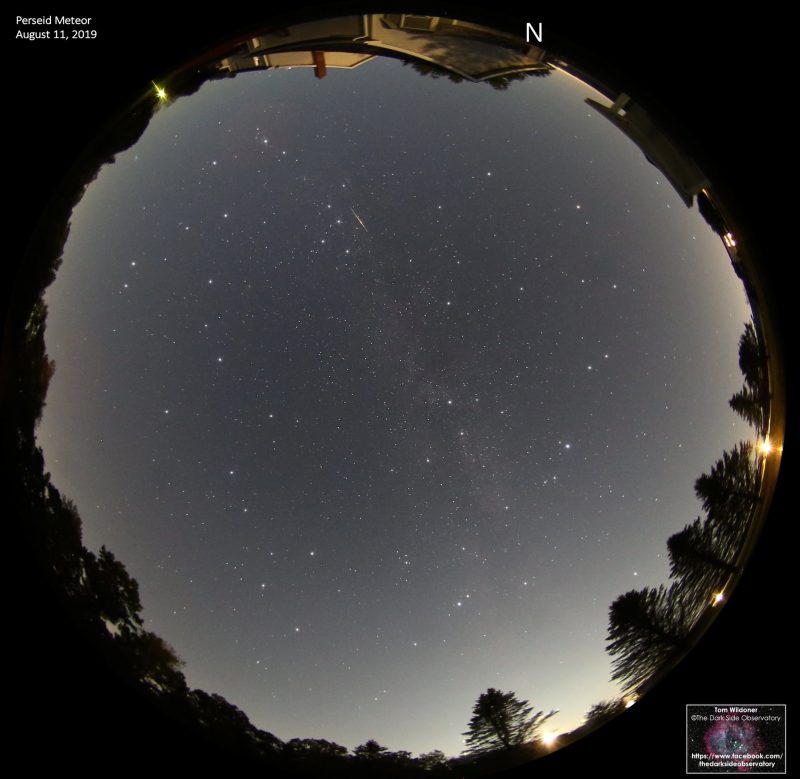

The constellation Cassiopeia is M- or W-shaped, ascending in the northeast on Northern Hemisphere autumn evenings. Perseus follows Cassiopeia in a great arc around the northern sky. Be sure to look for the star Algol, sometimes called the Ghoul Star or Demon Star … a perfect star for Halloween!
Let’s say you’re in the Northern Hemisphere, and you’re looking in a dark sky during the evening in autumn or winter. You can see the easy-to-spot constellation Cassiopeia the Queen, with its distinctive M or W shape, depending on what time of night you see it. What else should you look for? Try identifying the constellation next-door to Cassiopeia, which is called Perseus the Hero. As seen from our part of the globe, Perseus rises in the northeast behind Cassiopeia and follows Cassiopeia in a great arc across the northern night sky.
Cassiopeia is easy to identify and so it is one of the most famous constellations in the sky. Perseus is fainter than Cassiopeia, and its stars are not so easy to identify. But if you have access to a dark sky, you’ll spot the graceful shape of Perseus. [Deborah: I always think of this constellation as “dancing,” although its association is one of the most gruesome in skylore. See the image and caption below.]

The constellation Perseus. In skylore, Perseus was said to have beheaded Medusa, a witch who had snakes in place of hair. This image is from Urania’s Mirror, a set of constellation cards published in London around 1825. Image via Wikimedia Commons.
You’ll see both Cassiopeia and Perseus in the northeast on an October evening, and higher up in the evening sky in late autumn and winter. Or, as night passes, you’ll see them both ascending in the northeast – then arcing high in the north – then descending in the northwest – with Perseus following Cassiopeia all the while. Both Perseus and Cassiopeia are considered to be circumpolar from about 40 degrees N. latitude to further north. In other words, as seen from northern parts of the U.S. and Canada, they never set below the horizon, but instead circle endlessly around Polaris, the North Star.
The brightest star in Cassiopeia is Shedar.
The brightest star in Perseus is Mirfak, and you’ll also want to identify the most famous star in Perseus: Algol, the Demon Star.
After you’ve found Cassiopeia and Perseus, be sure to scan with your binoculars between them. Assuming your sky is dark, you’ll easily spot the magnificent Double Cluster in Perseus.

The constellation Cassiopeia points out the Double Cluster in northern tip of the constellation Perseus. Faintly visible to the unaided eye on a dark night, it’s better viewed with an optical aid. The Double Cluster nearly marks the radiant of the Perseid meteor shower. Photo credit: madmiked

View larger.| The Double Cluster in Perseus, via Tom Wildoner at The Dark Side Observatory in Weatherly, Pennsylvania.
And, although they are best seen in the evening in autumn and winter, you can also see Cassiopeia and Perseus in the latter part of Northern Hemisphere summer, from late night until dawn. The annual Perseid meteor shower peaks around August 12 or 13, and if you trace the paths of these Perseid meteors backwards, they will appear to originate between these constellations.

The radiant point of August’s famous Perseid meteor shower is between Cassiopeia and Perseus. Chart via SkyandTelescope.com

View at EarthSky Community Photos. | Tom Wildoner of the Dark Side Observatory in Weatherly, Pennsylvania, has an automatic camera set-up for meteor observing. He caught this one on August 11, 2019, and wrote: “You can see this bright meteor streak above center near the constellation Cassiopeia (sideways W) and pointing in the direction of Perseus. The brighter stars have been enhanced in this image to help orient your view, North is marked on the image.” Thanks, Tom!
Bottom line: Look for the constellations Cassiopeia and Perseus in the northern evening sky during the upcoming winter months.
Source:
https://earthsky.org/constellations/cassiopeia-and-perseus-in-northeast-on-october-evenings